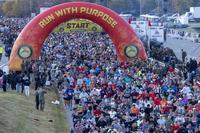As you age, it is best to implement as many non-impact cardio options to your training program as you can, whether that is biking, elliptical, rowing or swimming.
Sometimes after decades of running and rucking, the body will prefer these options. It also depends upon what you actually prefer, and learning to like one of these options might serve you well later in life. Here is an email from a retired Army National Guard member seeking some advice on how to add swimming to his day:
Hey, Stew -- I just turned 65 and I am looking forward to "Tactical Fitness (40+) Foundation Rebuilding." I put in 24 years in the regular Army Reserves and California Army National Guard. I retired last Tuesday from my regular job with 37.5 years. So now I need to get back into better fitness condition.
You really have created an inspirational movement in your Tactical Athlete program. My question is: “What is your typical swim training like?“ I do SCUBA training on Mondays and a swim workout on Fridays. Take care! Dave
Dave, thanks. I love swimming. I have been doing it for a long time and know I will be doing more of it as I age. So, yes, I agree that you should add more swimming to your training programming as you move into your 70s and 80s. I typically swim five days a week at the end of workouts in the weight room/running or cardio room.
I do a few things that really help with feeling great after a workout.
1. 10-minute tread water warmup. Tread with no hands and with hands only. Use a variety of kicking and arm pulls to work your hips and shoulders.
2. Swim 15-20 minutes (minimum), some days longer, and up to 45-60 minutes -- both with and without fins.
3. Do all of the dynamic stretches you can think of in chest-deep water (leg swings, butt kickers, run in place, etc.) Also known as the Mobility Day Off.
That will help you leave the gym feeling no pain, and that is a great thing.
For those of you who have no access to a pool, that is fine. There are plenty of other non-impact cardio options for you. Here is a related article on the variety of non-impact cardio options and the benefits of mixing these into your training program.
Stew
Stew Smith is a former Navy SEAL and fitness author certified as a Strength and Conditioning Specialist (CSCS) with the National Strength and Conditioning Association. Visit his Fitness eBook store if you’re looking to start a workout program to create a healthy lifestyle. Send your fitness questions to stew@stewsmith.com.
Want to Learn More About Military Life?
Whether you're thinking of joining the military, looking for fitness and basic training tips, or keeping up with military life and benefits, Military.com has you covered. Subscribe to Military.com to have military news, updates and resources delivered directly to your inbox.



















